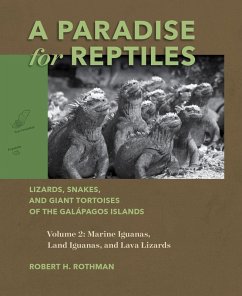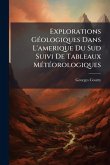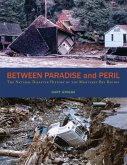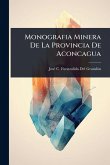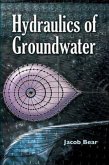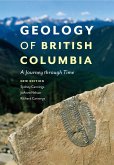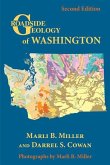Robert H Rothman
A Paradise for Reptiles
Lizards, Snakes, and Giant Tortoises of the Galápagos Islands, Volume 2: Marine Iguanas, Land Iguanas, and Lava Lizards Volume 2
Robert H Rothman
A Paradise for Reptiles
Lizards, Snakes, and Giant Tortoises of the Galápagos Islands, Volume 2: Marine Iguanas, Land Iguanas, and Lava Lizards Volume 2
- Broschiertes Buch
- Merkliste
- Auf die Merkliste
- Bewerten Bewerten
- Teilen
- Produkt teilen
- Produkterinnerung
- Produkterinnerung
A continuation of volume one focused on marine iguanas, land iguanas, and lava lizards, each of which offers key insights into evolution in the Galápagos Islands. Reptiles are intrinsic to the mystique of the Galápagos Islands, and A Paradise for Reptiles: Lizards, Snakes, and Giant Tortoises of the Galápagos Islands tells the story of these iconic animals and details the early encounters with each species, including the route by which they were recognized and named. Robert H. Rothman draws from a wide range of scientific literature to present an accessible, comprehensive account of the…mehr
Andere Kunden interessierten sich auch für
![Explorations GÃ(c)ologiques Dans L'amerique Du Sud Suivi De Tableaux MÃ(c)tÃ(c)orologiques Explorations GÃ(c)ologiques Dans L'amerique Du Sud Suivi De Tableaux MÃ(c)tÃ(c)orologiques]() Georges CourtyExplorations GÃ(c)ologiques Dans L'amerique Du Sud Suivi De Tableaux MÃ(c)tÃ(c)orologiques22,99 €
Georges CourtyExplorations GÃ(c)ologiques Dans L'amerique Du Sud Suivi De Tableaux MÃ(c)tÃ(c)orologiques22,99 €![Between Paradise and Peril Between Paradise and Peril]() Gary GriggsBetween Paradise and Peril52,99 €
Gary GriggsBetween Paradise and Peril52,99 €![Monografia Minera De La Provincia De Aconcagua Monografia Minera De La Provincia De Aconcagua]() Josã del Grandã3n (c) C FuenzalidaMonografia Minera De La Provincia De Aconcagua20,99 €
Josã del Grandã3n (c) C FuenzalidaMonografia Minera De La Provincia De Aconcagua20,99 €![Hydraulics of Groundwater Hydraulics of Groundwater]() Jacob BearHydraulics of Groundwater24,99 €
Jacob BearHydraulics of Groundwater24,99 €![The Broken Land The Broken Land]() Frank DecourtenThe Broken Land19,99 €
Frank DecourtenThe Broken Land19,99 €![Geology of British Columbia Geology of British Columbia]() Sydney CanningsGeology of British Columbia17,99 €
Sydney CanningsGeology of British Columbia17,99 €![Roadside Geology of Washington Roadside Geology of Washington]() Marli B MillerRoadside Geology of Washington21,99 €
Marli B MillerRoadside Geology of Washington21,99 €-
-
-
A continuation of volume one focused on marine iguanas, land iguanas, and lava lizards, each of which offers key insights into evolution in the Galápagos Islands. Reptiles are intrinsic to the mystique of the Galápagos Islands, and A Paradise for Reptiles: Lizards, Snakes, and Giant Tortoises of the Galápagos Islands tells the story of these iconic animals and details the early encounters with each species, including the route by which they were recognized and named. Robert H. Rothman draws from a wide range of scientific literature to present an accessible, comprehensive account of the research on the natural history, behavioral ecology, physiology, genetics, and conservation of each major group. A Paradise for Reptiles is richly supplemented with thirty years of photographs taken by the author during annual trips to the Galápagos. Volume 2: Marine Iguanas, Land Iguanas, and Lava Lizards continues the story of Galápagos reptiles with accounts of these three representatives of the family Iguanidae. In the historic literature, marine iguanas were reviled for their apparent ugliness, while lava lizards were generally ignored. However, each of the three lizards offers key insights into evolution in the Galápagos Islands.
Produktdetails
- Produktdetails
- Verlag: Rochester Institute of Technology, Rit Press
- Seitenzahl: 280
- Erscheinungstermin: 15. September 2025
- Englisch
- Abmessung: 280mm x 230mm x 20mm
- Gewicht: 1383g
- ISBN-13: 9781956313178
- ISBN-10: 1956313176
- Artikelnr.: 75402580
- Herstellerkennzeichnung
- Libri GmbH
- Europaallee 1
- 36244 Bad Hersfeld
- gpsr@libri.de
- Verlag: Rochester Institute of Technology, Rit Press
- Seitenzahl: 280
- Erscheinungstermin: 15. September 2025
- Englisch
- Abmessung: 280mm x 230mm x 20mm
- Gewicht: 1383g
- ISBN-13: 9781956313178
- ISBN-10: 1956313176
- Artikelnr.: 75402580
- Herstellerkennzeichnung
- Libri GmbH
- Europaallee 1
- 36244 Bad Hersfeld
- gpsr@libri.de
ROBERT H. ROTHMAN, PhD, is Professor Emeritus, Thomas H. Gosnell School of Life Sciences, at Rochester Institute of Technology in Rochester, New York. He initiated, taught, and led thirty-two annual trips to the Galápagos Islands for science and nonscience RIT students.
Preface xiii 1. In the Galápagos, Reptiles xvi 1.1 Lizard City 1 1.2 Imps
of Darkness 2 1.3 A Singularly Stupid Appearance 3 1.4 Very Harmless
Animals 3 1.5 Endangered Reptiles 3 1.6 A Paradise for Reptiles 4 2. Marine
Iguanas-Amblyrhynchus 6 2.1 So Strange a Lizard 7 2.2 Intertidal and
Subtidal Foraging 12 2.2.1 Subtidal Foraging 13 2.2.2 Choice of Foraging
Mode 14 2.2.3 Intertidal Foraging and Body Size 15 2.2.4 Intertidal
Foraging and Tidal Cycles 16 2.3 Diet 19 2.3.1 Macrophytic Algae 19 2.3.2
Comparison of Adult and Juvenile Diets 20 2.3.3 Niche Expansion 21 2.4 Gut
Microbiome 22 2.4.1 Microbial Diversity 23 2.4.2. Microbiome Diversity
Across Sites 26 2.4.3. Bacterial Antibiotic Resistance 27 2.4.4 Microbiome
Diversity and Starvation 28 2.5 Physiology 29 2.5.1 Energetics 29 2.5.2 The
Metabolic Cost of Subtidal Foraging 30 2.5.3 Thermoregulation 32 2.5.4 Salt
Balance 37 2.5.5 How Specialized Are Marine Iguanas? 38 2.6 Reproduction 41
2.6.1 Territoriality and the Onset of Mating 42 2.6.2 Territories, Leks,
and Hotshot Males 47 2.6.3 Marginal Males and Sneakers 48 2.6.4
Testosterone and Territoriality 48 2.6.5 Ladies Choice 49 2.6.6 Nesting 50
2.6.7 Hormonal Cycles and Reproductive Behavior 53 2.6.8 Hatchlings 54 2.7
Body Size 54 2.7.1 Body Size and Environmental Conditions 56 2.7.2 Body
Size and Sexual Dimorphism 57 2.8 El Niño 58 2.8.1 Mortality 61 2.8.2.
Cause of Death 63 2.8.3 El Niño and Reproduction 64 2.8.4 Recovery 64 2.8.5
El Niño, Population Crashes, and Genetic Diversity 65 2.9 The Stressful
Life of Marine Iguanas 66 2.9.1 The Hormonal Response to Stress 66 2.9.2
Daily and Seasonal Modulation of Stress Hormones 67 2.9.3 Predation and
Stress 69 2.9.4 Tourism and Stress 74 2.9.5 El Niño and Stress 76 2.9.6 The
Jessica Oil Spill and Stress 79 2.10 Parasites 79 2.10.1 Ticks 79 2.10.2.
Hemoparasites 83 2.11 Genetic Diversity and Dispersal 85 2.11.1
Evolutionary Age of Marine Iguanas 85 2.11.2 Island-Specific Genetic
Clusters 85 2.11.3 Subspecies 90 2.12 Femoral Glands: Lipidomics and
Proteomics 93 2.13 Conservation 95 2.13.1 Natural Threats 95 2.13.2.
Anthropogenic Threats 96 2.13.3 Population Counts 98 2.13.4 Molecular
Approaches to Conservation 100 3. Land Iguanas-Conolophus 102 3.1 The Land
Iguana Named 103 3.2 Three Species of Land Iguana 105 3.3 Diet 110 3.3.1.
Preferred Foods 110 3.3.2 Land Iguanas as Seed Dispersers 116 3.3.3 Land
Iguanas as Ecosystem Engineers 118 3.4 Land Iguana Physiology 120 3.4.1
Energetics 120 3.4.2 Thermoregulation 121 3.5 Territoriality 128 3.5.1
Territorial Display 128 3.5.2 Home Ranges 129 3.6 Reproduction 132 3.6.1
Establishment of Male Mating Territories 133 3.6.2 Male Courtship Display
134 3.6.3 Copulation 134 3.6.4 Nesting 135 3.6.5 Metabolic Cost of
Migration to Nesting Grounds 136 3.6.6 Clutch Size 137 3.6.7 Eggs 138 3.6.8
Hatchlings 140 3.6.9 Timing of Reproduction 143 3.6.10 Reproduction in
Conolophus Marthae and Conolophus Subcristatus on Volcán Wolf 144 3.7
Predators and Parasites 146 3.8 Genetic Diversity 150 3.8.1 Morphological
Assessment of Diversity 150 3.8.2 DNA Assessment of Diversity 151 3.9
Evolutionary Relationships 155 3.9.1 Phylogeny Based on Morphology 156
3.9.2 Phylogeny Based on Immunology 156 3.9.3 Amblyrhynchus-Conolophus
Hybrids 157 3.9.4 Mainland Connections 160 3.10 Conservation 163 3.10.1 The
Land Iguanas of Bahia Cartago, Isabela, and Cerro Dragón, Santa Cruz 164
3.10.2 The Land Iguanas of Baltra 166 3.10.3 Conolophus Marthae 169 4. Lava
Lizards-Microlophus 172 4.1 The Lava Lizard Named 173 4.2 Territoriality
182 4.2.1 Home Ranges 183 4.2.2 Male Territoriality 183 4.2.3 Provisional
Male Territoriality 187 4.2.4 Female Territoriality 188 4.2.5 Population
Density and Territoriality 190 4.2.6 Species-Specific Display Patterns and
Conspecific Display Recognition 190 4.3 Reproduction 193 4.3.1 Courtship
and Mating 193 4.3.2 Nesting 196 4.3.3 Annual Reproductive Cycle and Clutch
Size 197 4.4 Growth and Life Span 200 4.5 Diet 201 4.6 Thermoregulation and
Daily Routine 207 4.7 Predators and Predation 209 4.8 Evolution and
Colonization 214 4.8.1 Phylogeny Based on Immunology and Electrophoresis
214 4.8.2 Phylogeny Based on DNA Analysis 217 4.9 Conservation 222 5.
Afterword 224 5.1 Early Encounters 225 5.2 Changing Taxonomies 225 5.3 Life
Histories 226 5.4 Evolution 227 5.5 Colonization 228 5.6 Conservation 229
5.7 Concluding Remarks 230 Addendum 233 Galápagos Tortoises and the Species
Question 233 A Fossil Giant Tortoise from Coastal Ecuador 234 Cranial
Anatomy of the Marine Iguana 234 A New Species of Lava Lizard 235
Trafficking of Galápagos Iguanas 236 References 237 References 239 Index
257
of Darkness 2 1.3 A Singularly Stupid Appearance 3 1.4 Very Harmless
Animals 3 1.5 Endangered Reptiles 3 1.6 A Paradise for Reptiles 4 2. Marine
Iguanas-Amblyrhynchus 6 2.1 So Strange a Lizard 7 2.2 Intertidal and
Subtidal Foraging 12 2.2.1 Subtidal Foraging 13 2.2.2 Choice of Foraging
Mode 14 2.2.3 Intertidal Foraging and Body Size 15 2.2.4 Intertidal
Foraging and Tidal Cycles 16 2.3 Diet 19 2.3.1 Macrophytic Algae 19 2.3.2
Comparison of Adult and Juvenile Diets 20 2.3.3 Niche Expansion 21 2.4 Gut
Microbiome 22 2.4.1 Microbial Diversity 23 2.4.2. Microbiome Diversity
Across Sites 26 2.4.3. Bacterial Antibiotic Resistance 27 2.4.4 Microbiome
Diversity and Starvation 28 2.5 Physiology 29 2.5.1 Energetics 29 2.5.2 The
Metabolic Cost of Subtidal Foraging 30 2.5.3 Thermoregulation 32 2.5.4 Salt
Balance 37 2.5.5 How Specialized Are Marine Iguanas? 38 2.6 Reproduction 41
2.6.1 Territoriality and the Onset of Mating 42 2.6.2 Territories, Leks,
and Hotshot Males 47 2.6.3 Marginal Males and Sneakers 48 2.6.4
Testosterone and Territoriality 48 2.6.5 Ladies Choice 49 2.6.6 Nesting 50
2.6.7 Hormonal Cycles and Reproductive Behavior 53 2.6.8 Hatchlings 54 2.7
Body Size 54 2.7.1 Body Size and Environmental Conditions 56 2.7.2 Body
Size and Sexual Dimorphism 57 2.8 El Niño 58 2.8.1 Mortality 61 2.8.2.
Cause of Death 63 2.8.3 El Niño and Reproduction 64 2.8.4 Recovery 64 2.8.5
El Niño, Population Crashes, and Genetic Diversity 65 2.9 The Stressful
Life of Marine Iguanas 66 2.9.1 The Hormonal Response to Stress 66 2.9.2
Daily and Seasonal Modulation of Stress Hormones 67 2.9.3 Predation and
Stress 69 2.9.4 Tourism and Stress 74 2.9.5 El Niño and Stress 76 2.9.6 The
Jessica Oil Spill and Stress 79 2.10 Parasites 79 2.10.1 Ticks 79 2.10.2.
Hemoparasites 83 2.11 Genetic Diversity and Dispersal 85 2.11.1
Evolutionary Age of Marine Iguanas 85 2.11.2 Island-Specific Genetic
Clusters 85 2.11.3 Subspecies 90 2.12 Femoral Glands: Lipidomics and
Proteomics 93 2.13 Conservation 95 2.13.1 Natural Threats 95 2.13.2.
Anthropogenic Threats 96 2.13.3 Population Counts 98 2.13.4 Molecular
Approaches to Conservation 100 3. Land Iguanas-Conolophus 102 3.1 The Land
Iguana Named 103 3.2 Three Species of Land Iguana 105 3.3 Diet 110 3.3.1.
Preferred Foods 110 3.3.2 Land Iguanas as Seed Dispersers 116 3.3.3 Land
Iguanas as Ecosystem Engineers 118 3.4 Land Iguana Physiology 120 3.4.1
Energetics 120 3.4.2 Thermoregulation 121 3.5 Territoriality 128 3.5.1
Territorial Display 128 3.5.2 Home Ranges 129 3.6 Reproduction 132 3.6.1
Establishment of Male Mating Territories 133 3.6.2 Male Courtship Display
134 3.6.3 Copulation 134 3.6.4 Nesting 135 3.6.5 Metabolic Cost of
Migration to Nesting Grounds 136 3.6.6 Clutch Size 137 3.6.7 Eggs 138 3.6.8
Hatchlings 140 3.6.9 Timing of Reproduction 143 3.6.10 Reproduction in
Conolophus Marthae and Conolophus Subcristatus on Volcán Wolf 144 3.7
Predators and Parasites 146 3.8 Genetic Diversity 150 3.8.1 Morphological
Assessment of Diversity 150 3.8.2 DNA Assessment of Diversity 151 3.9
Evolutionary Relationships 155 3.9.1 Phylogeny Based on Morphology 156
3.9.2 Phylogeny Based on Immunology 156 3.9.3 Amblyrhynchus-Conolophus
Hybrids 157 3.9.4 Mainland Connections 160 3.10 Conservation 163 3.10.1 The
Land Iguanas of Bahia Cartago, Isabela, and Cerro Dragón, Santa Cruz 164
3.10.2 The Land Iguanas of Baltra 166 3.10.3 Conolophus Marthae 169 4. Lava
Lizards-Microlophus 172 4.1 The Lava Lizard Named 173 4.2 Territoriality
182 4.2.1 Home Ranges 183 4.2.2 Male Territoriality 183 4.2.3 Provisional
Male Territoriality 187 4.2.4 Female Territoriality 188 4.2.5 Population
Density and Territoriality 190 4.2.6 Species-Specific Display Patterns and
Conspecific Display Recognition 190 4.3 Reproduction 193 4.3.1 Courtship
and Mating 193 4.3.2 Nesting 196 4.3.3 Annual Reproductive Cycle and Clutch
Size 197 4.4 Growth and Life Span 200 4.5 Diet 201 4.6 Thermoregulation and
Daily Routine 207 4.7 Predators and Predation 209 4.8 Evolution and
Colonization 214 4.8.1 Phylogeny Based on Immunology and Electrophoresis
214 4.8.2 Phylogeny Based on DNA Analysis 217 4.9 Conservation 222 5.
Afterword 224 5.1 Early Encounters 225 5.2 Changing Taxonomies 225 5.3 Life
Histories 226 5.4 Evolution 227 5.5 Colonization 228 5.6 Conservation 229
5.7 Concluding Remarks 230 Addendum 233 Galápagos Tortoises and the Species
Question 233 A Fossil Giant Tortoise from Coastal Ecuador 234 Cranial
Anatomy of the Marine Iguana 234 A New Species of Lava Lizard 235
Trafficking of Galápagos Iguanas 236 References 237 References 239 Index
257
Preface xiii 1. In the Galápagos, Reptiles xvi 1.1 Lizard City 1 1.2 Imps
of Darkness 2 1.3 A Singularly Stupid Appearance 3 1.4 Very Harmless
Animals 3 1.5 Endangered Reptiles 3 1.6 A Paradise for Reptiles 4 2. Marine
Iguanas-Amblyrhynchus 6 2.1 So Strange a Lizard 7 2.2 Intertidal and
Subtidal Foraging 12 2.2.1 Subtidal Foraging 13 2.2.2 Choice of Foraging
Mode 14 2.2.3 Intertidal Foraging and Body Size 15 2.2.4 Intertidal
Foraging and Tidal Cycles 16 2.3 Diet 19 2.3.1 Macrophytic Algae 19 2.3.2
Comparison of Adult and Juvenile Diets 20 2.3.3 Niche Expansion 21 2.4 Gut
Microbiome 22 2.4.1 Microbial Diversity 23 2.4.2. Microbiome Diversity
Across Sites 26 2.4.3. Bacterial Antibiotic Resistance 27 2.4.4 Microbiome
Diversity and Starvation 28 2.5 Physiology 29 2.5.1 Energetics 29 2.5.2 The
Metabolic Cost of Subtidal Foraging 30 2.5.3 Thermoregulation 32 2.5.4 Salt
Balance 37 2.5.5 How Specialized Are Marine Iguanas? 38 2.6 Reproduction 41
2.6.1 Territoriality and the Onset of Mating 42 2.6.2 Territories, Leks,
and Hotshot Males 47 2.6.3 Marginal Males and Sneakers 48 2.6.4
Testosterone and Territoriality 48 2.6.5 Ladies Choice 49 2.6.6 Nesting 50
2.6.7 Hormonal Cycles and Reproductive Behavior 53 2.6.8 Hatchlings 54 2.7
Body Size 54 2.7.1 Body Size and Environmental Conditions 56 2.7.2 Body
Size and Sexual Dimorphism 57 2.8 El Niño 58 2.8.1 Mortality 61 2.8.2.
Cause of Death 63 2.8.3 El Niño and Reproduction 64 2.8.4 Recovery 64 2.8.5
El Niño, Population Crashes, and Genetic Diversity 65 2.9 The Stressful
Life of Marine Iguanas 66 2.9.1 The Hormonal Response to Stress 66 2.9.2
Daily and Seasonal Modulation of Stress Hormones 67 2.9.3 Predation and
Stress 69 2.9.4 Tourism and Stress 74 2.9.5 El Niño and Stress 76 2.9.6 The
Jessica Oil Spill and Stress 79 2.10 Parasites 79 2.10.1 Ticks 79 2.10.2.
Hemoparasites 83 2.11 Genetic Diversity and Dispersal 85 2.11.1
Evolutionary Age of Marine Iguanas 85 2.11.2 Island-Specific Genetic
Clusters 85 2.11.3 Subspecies 90 2.12 Femoral Glands: Lipidomics and
Proteomics 93 2.13 Conservation 95 2.13.1 Natural Threats 95 2.13.2.
Anthropogenic Threats 96 2.13.3 Population Counts 98 2.13.4 Molecular
Approaches to Conservation 100 3. Land Iguanas-Conolophus 102 3.1 The Land
Iguana Named 103 3.2 Three Species of Land Iguana 105 3.3 Diet 110 3.3.1.
Preferred Foods 110 3.3.2 Land Iguanas as Seed Dispersers 116 3.3.3 Land
Iguanas as Ecosystem Engineers 118 3.4 Land Iguana Physiology 120 3.4.1
Energetics 120 3.4.2 Thermoregulation 121 3.5 Territoriality 128 3.5.1
Territorial Display 128 3.5.2 Home Ranges 129 3.6 Reproduction 132 3.6.1
Establishment of Male Mating Territories 133 3.6.2 Male Courtship Display
134 3.6.3 Copulation 134 3.6.4 Nesting 135 3.6.5 Metabolic Cost of
Migration to Nesting Grounds 136 3.6.6 Clutch Size 137 3.6.7 Eggs 138 3.6.8
Hatchlings 140 3.6.9 Timing of Reproduction 143 3.6.10 Reproduction in
Conolophus Marthae and Conolophus Subcristatus on Volcán Wolf 144 3.7
Predators and Parasites 146 3.8 Genetic Diversity 150 3.8.1 Morphological
Assessment of Diversity 150 3.8.2 DNA Assessment of Diversity 151 3.9
Evolutionary Relationships 155 3.9.1 Phylogeny Based on Morphology 156
3.9.2 Phylogeny Based on Immunology 156 3.9.3 Amblyrhynchus-Conolophus
Hybrids 157 3.9.4 Mainland Connections 160 3.10 Conservation 163 3.10.1 The
Land Iguanas of Bahia Cartago, Isabela, and Cerro Dragón, Santa Cruz 164
3.10.2 The Land Iguanas of Baltra 166 3.10.3 Conolophus Marthae 169 4. Lava
Lizards-Microlophus 172 4.1 The Lava Lizard Named 173 4.2 Territoriality
182 4.2.1 Home Ranges 183 4.2.2 Male Territoriality 183 4.2.3 Provisional
Male Territoriality 187 4.2.4 Female Territoriality 188 4.2.5 Population
Density and Territoriality 190 4.2.6 Species-Specific Display Patterns and
Conspecific Display Recognition 190 4.3 Reproduction 193 4.3.1 Courtship
and Mating 193 4.3.2 Nesting 196 4.3.3 Annual Reproductive Cycle and Clutch
Size 197 4.4 Growth and Life Span 200 4.5 Diet 201 4.6 Thermoregulation and
Daily Routine 207 4.7 Predators and Predation 209 4.8 Evolution and
Colonization 214 4.8.1 Phylogeny Based on Immunology and Electrophoresis
214 4.8.2 Phylogeny Based on DNA Analysis 217 4.9 Conservation 222 5.
Afterword 224 5.1 Early Encounters 225 5.2 Changing Taxonomies 225 5.3 Life
Histories 226 5.4 Evolution 227 5.5 Colonization 228 5.6 Conservation 229
5.7 Concluding Remarks 230 Addendum 233 Galápagos Tortoises and the Species
Question 233 A Fossil Giant Tortoise from Coastal Ecuador 234 Cranial
Anatomy of the Marine Iguana 234 A New Species of Lava Lizard 235
Trafficking of Galápagos Iguanas 236 References 237 References 239 Index
257
of Darkness 2 1.3 A Singularly Stupid Appearance 3 1.4 Very Harmless
Animals 3 1.5 Endangered Reptiles 3 1.6 A Paradise for Reptiles 4 2. Marine
Iguanas-Amblyrhynchus 6 2.1 So Strange a Lizard 7 2.2 Intertidal and
Subtidal Foraging 12 2.2.1 Subtidal Foraging 13 2.2.2 Choice of Foraging
Mode 14 2.2.3 Intertidal Foraging and Body Size 15 2.2.4 Intertidal
Foraging and Tidal Cycles 16 2.3 Diet 19 2.3.1 Macrophytic Algae 19 2.3.2
Comparison of Adult and Juvenile Diets 20 2.3.3 Niche Expansion 21 2.4 Gut
Microbiome 22 2.4.1 Microbial Diversity 23 2.4.2. Microbiome Diversity
Across Sites 26 2.4.3. Bacterial Antibiotic Resistance 27 2.4.4 Microbiome
Diversity and Starvation 28 2.5 Physiology 29 2.5.1 Energetics 29 2.5.2 The
Metabolic Cost of Subtidal Foraging 30 2.5.3 Thermoregulation 32 2.5.4 Salt
Balance 37 2.5.5 How Specialized Are Marine Iguanas? 38 2.6 Reproduction 41
2.6.1 Territoriality and the Onset of Mating 42 2.6.2 Territories, Leks,
and Hotshot Males 47 2.6.3 Marginal Males and Sneakers 48 2.6.4
Testosterone and Territoriality 48 2.6.5 Ladies Choice 49 2.6.6 Nesting 50
2.6.7 Hormonal Cycles and Reproductive Behavior 53 2.6.8 Hatchlings 54 2.7
Body Size 54 2.7.1 Body Size and Environmental Conditions 56 2.7.2 Body
Size and Sexual Dimorphism 57 2.8 El Niño 58 2.8.1 Mortality 61 2.8.2.
Cause of Death 63 2.8.3 El Niño and Reproduction 64 2.8.4 Recovery 64 2.8.5
El Niño, Population Crashes, and Genetic Diversity 65 2.9 The Stressful
Life of Marine Iguanas 66 2.9.1 The Hormonal Response to Stress 66 2.9.2
Daily and Seasonal Modulation of Stress Hormones 67 2.9.3 Predation and
Stress 69 2.9.4 Tourism and Stress 74 2.9.5 El Niño and Stress 76 2.9.6 The
Jessica Oil Spill and Stress 79 2.10 Parasites 79 2.10.1 Ticks 79 2.10.2.
Hemoparasites 83 2.11 Genetic Diversity and Dispersal 85 2.11.1
Evolutionary Age of Marine Iguanas 85 2.11.2 Island-Specific Genetic
Clusters 85 2.11.3 Subspecies 90 2.12 Femoral Glands: Lipidomics and
Proteomics 93 2.13 Conservation 95 2.13.1 Natural Threats 95 2.13.2.
Anthropogenic Threats 96 2.13.3 Population Counts 98 2.13.4 Molecular
Approaches to Conservation 100 3. Land Iguanas-Conolophus 102 3.1 The Land
Iguana Named 103 3.2 Three Species of Land Iguana 105 3.3 Diet 110 3.3.1.
Preferred Foods 110 3.3.2 Land Iguanas as Seed Dispersers 116 3.3.3 Land
Iguanas as Ecosystem Engineers 118 3.4 Land Iguana Physiology 120 3.4.1
Energetics 120 3.4.2 Thermoregulation 121 3.5 Territoriality 128 3.5.1
Territorial Display 128 3.5.2 Home Ranges 129 3.6 Reproduction 132 3.6.1
Establishment of Male Mating Territories 133 3.6.2 Male Courtship Display
134 3.6.3 Copulation 134 3.6.4 Nesting 135 3.6.5 Metabolic Cost of
Migration to Nesting Grounds 136 3.6.6 Clutch Size 137 3.6.7 Eggs 138 3.6.8
Hatchlings 140 3.6.9 Timing of Reproduction 143 3.6.10 Reproduction in
Conolophus Marthae and Conolophus Subcristatus on Volcán Wolf 144 3.7
Predators and Parasites 146 3.8 Genetic Diversity 150 3.8.1 Morphological
Assessment of Diversity 150 3.8.2 DNA Assessment of Diversity 151 3.9
Evolutionary Relationships 155 3.9.1 Phylogeny Based on Morphology 156
3.9.2 Phylogeny Based on Immunology 156 3.9.3 Amblyrhynchus-Conolophus
Hybrids 157 3.9.4 Mainland Connections 160 3.10 Conservation 163 3.10.1 The
Land Iguanas of Bahia Cartago, Isabela, and Cerro Dragón, Santa Cruz 164
3.10.2 The Land Iguanas of Baltra 166 3.10.3 Conolophus Marthae 169 4. Lava
Lizards-Microlophus 172 4.1 The Lava Lizard Named 173 4.2 Territoriality
182 4.2.1 Home Ranges 183 4.2.2 Male Territoriality 183 4.2.3 Provisional
Male Territoriality 187 4.2.4 Female Territoriality 188 4.2.5 Population
Density and Territoriality 190 4.2.6 Species-Specific Display Patterns and
Conspecific Display Recognition 190 4.3 Reproduction 193 4.3.1 Courtship
and Mating 193 4.3.2 Nesting 196 4.3.3 Annual Reproductive Cycle and Clutch
Size 197 4.4 Growth and Life Span 200 4.5 Diet 201 4.6 Thermoregulation and
Daily Routine 207 4.7 Predators and Predation 209 4.8 Evolution and
Colonization 214 4.8.1 Phylogeny Based on Immunology and Electrophoresis
214 4.8.2 Phylogeny Based on DNA Analysis 217 4.9 Conservation 222 5.
Afterword 224 5.1 Early Encounters 225 5.2 Changing Taxonomies 225 5.3 Life
Histories 226 5.4 Evolution 227 5.5 Colonization 228 5.6 Conservation 229
5.7 Concluding Remarks 230 Addendum 233 Galápagos Tortoises and the Species
Question 233 A Fossil Giant Tortoise from Coastal Ecuador 234 Cranial
Anatomy of the Marine Iguana 234 A New Species of Lava Lizard 235
Trafficking of Galápagos Iguanas 236 References 237 References 239 Index
257

